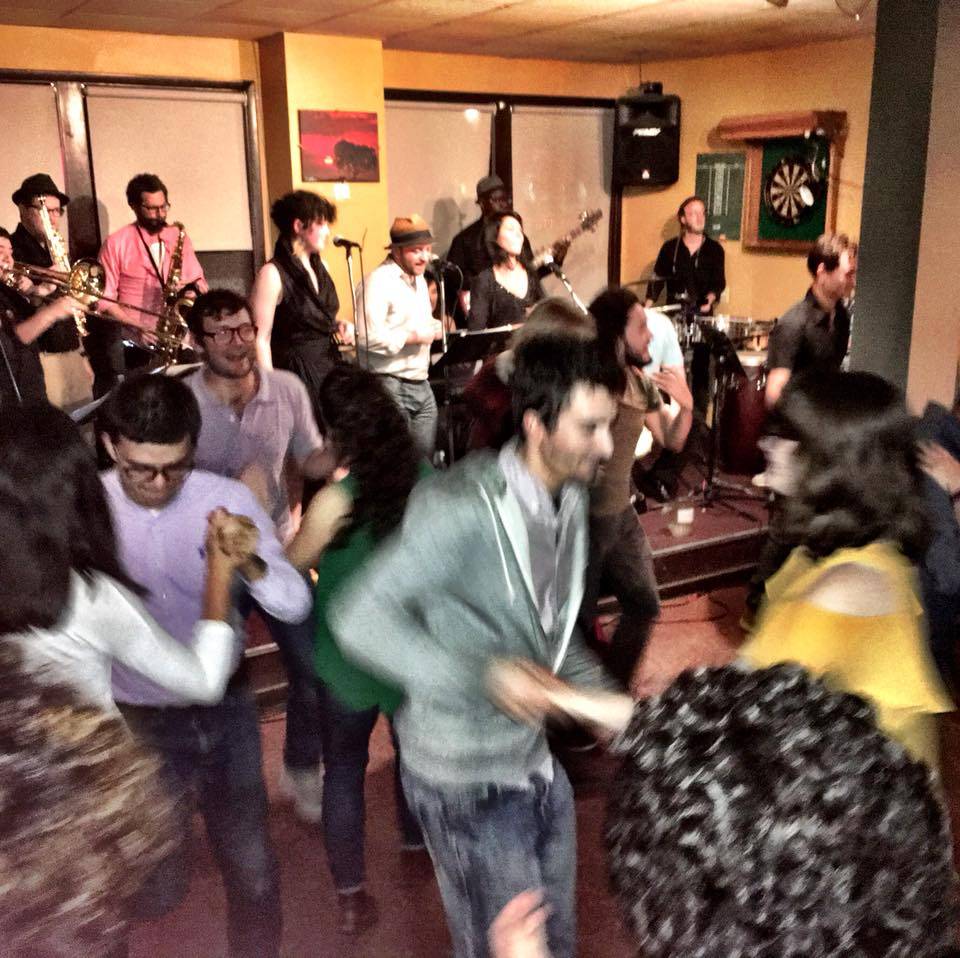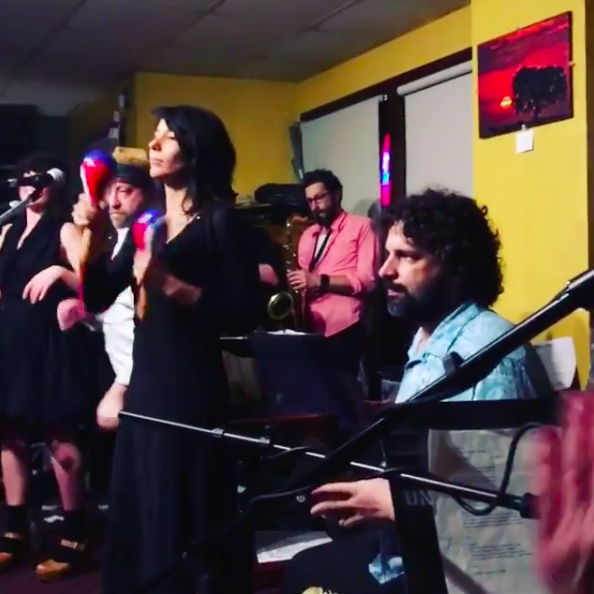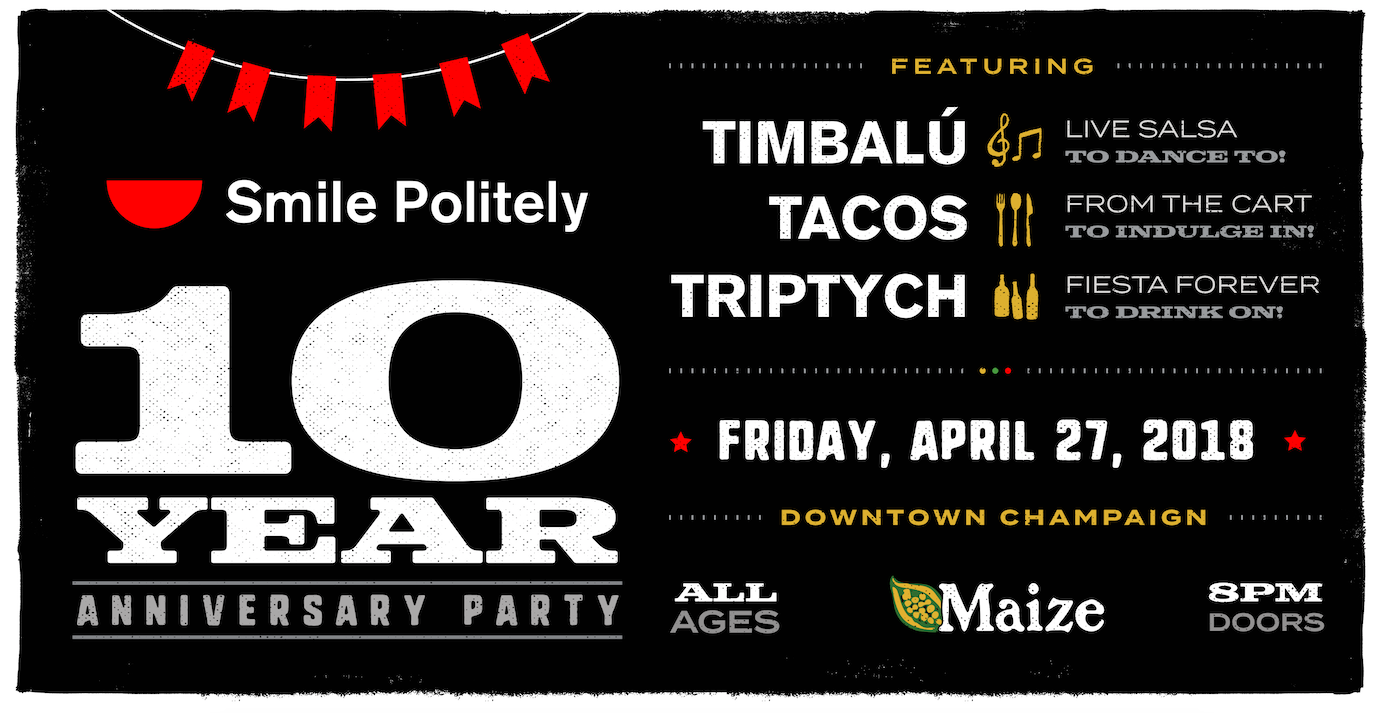Champaign-Urbana’s live music scene has a new flavor on offer — Salsa. As they have made their first steps into playing shows around C-U, Timbalú has filled a need many of us did not know we had. The super diverse group represents the diverse background that has been at the heart of Salsa’s DNA since its birth in the 1960s, which I learned about in my interview with wife and husband Lina Zambrano and Ian Middleton, members of Timbalú. Middleton sings, directs the band, and plays congas and Zambrano sings. She’s from Cali, Colombia, a hub and melting pot of Salsa and Latin American music, while he’s from London, England and moved to Colombia to learn about music.
When I came to their apartment for the interview, it happened to be a bit of a special occasion. Middleton had successfully defended his PhD. dissertation earlier that afternoon, and so I just happened to be lucky enough to join them in celebrating and the vibe was ripe for a great conversation about Salsa. Zambrano fired up the turntable, Middleton poured the wine.
I wanted to know more about the band, but I ended up learning way more about Salsa than I expected.
Smile Politely: First, how do you pronounce Timbalú?
Lina Zambrano: Tim-ba-LOO, with the accent on the LOO.
SP: Where did the name come from?
Ian Middleton: It’s a combination of two kinds of music. The second part, Boogaloo, was a thing that popped up in the mid-late 60s in New York, mainly among Puerto Rican — New Yorican people — living in New York with roots in Puerto Rico, who combined rhythms from the island and from the Caribbean with doo wap and rock ‘n roll, and things like that that were part of the black music scene in New York at the time, to form Boogaloo.
Zambrano: And it was really important in Cali.
Middleton: Yes, it was. Lina is from Cali in Colombia. They really dug Boogaloo. And folks there imported records from New York big time. Interestingly one thing they used to do is they would listen to Boogaloo which kinda has this slow feel — kinda a slow backbeat feel —
Zambrano: Like that [clapping along with the record playing on the turntable]…
Middleton: …and in Cali they would play it not at 33, but at 45 [rpms].
Zambrano: Like this [flips the turntable speed from 33 to 45, increasing the tempo of the music as she starts snapping her fingers to the quicker tempo]. And that’s where the way people dance comes from.
SP: Wow, so by technological mistake they invented a new type of music.
Middleton: Not by mistake — they did it on purpose. They were like, “this is cool, this is groovy, but we need it to dance it faster so you need to pick up the pace.” That’s the Boogaloo. And Timba is a kind of music that folks play in Cuba. What some people in Cuba would say is “we don’t really play salsa, we play timba, which is different”. It kinda sounds really similar, but it has more of a breadth of sounds. It’s more influenced by dance music from Cuba from the 50s, but also more modern sounds. They use synthesizers, full drum kit rather than just percussion, they’ll use electronic drum beats and things like that. So Timba has been big in Cuba since the 80s or 90s. And again, that’s huge in Cali too. And since those two slightly lesser known genres that are really big in Cali, and sort of on the edge of the salsa scene we thought those things sort of go together.
SP: How long have you been together as a band?
Middleton: We got together in the summer of last year. We started rehearsing together in August of last year. We played a couple of small shows last fall with just a song or two. And then the show you saw [and reviewed] at the Iron Post was our first real outing into public with a proper 3 hour set.

Photo by Paul Mueth
SP: I don’t know if you guys noticed, but there was a line out the door for a really long time.
Zambrano: We didn’t know!
Middleton: We didn’t know at the time. I had a friend say “I waited for an hour and a half to get in but I couldn’t so I went home”
SP: It sounds like salsa is a bit of a blanket term to incorporate different subgenres. Is that right?
Zambrano [to Middleton]: You just got your doctorate in that! Ethnomusicology.
Middleton: Yes, you’re absolutely right. Salsa is, or began at least, as an umbrella term that covered various subgenres. But through records and dancing those subgenres became eliminated to an extent, and so by about the 80s there came to be a singular sound that you would think of as salsa. And so now when people say salsa they mean something that you dance ba-ba-ba ba-ba-ba [snapping along with the rhythm]. However you do it, that’s the basic step. And it has things like Clave feel, like jink-jink-jink ca-jink-jink or pop-jink-jink ca-jink-ca-jink-ca-jink. And it has a standard percussion set up and all of those things. And now people contrast it with Merengue which is faster and you dance it with a one step [beatboxing Merengue], and Bachata which is popular in the US and a lot of places. It’s a slower one that’s like step step step uh, step step step uh. And there’s Cumbia, which has its roots in Columbia but it’s really big in Mexico.
Zambrano: And Argentina as well. And they’ve done something really different with it as well.
Middleton: And those are the things that people dance and distinguish from Salsa.
SP: What bands are your biggest inspiration or do you admire the most?
Zambrano: El Gran Combo from Puerto Rico. We’re playing stuff from these guys [music playing on the turntable], Fania All-Stars, which is like Latin American artists in New York that got together from different countries.
Middleton: Fania was a record label. They brought together artists and created a group, sort of a label group, called Fania All-Stars.
Zambrano: And they were really stars. We’re really far from them.
Middleton: Also Los Van Van from Cuba.
Zambrano: Also there are singers that get a band, but it’s under their name. Like Oscar D’Leon. We sing a song by him. He’s from Venezuela.
SP: I think maybe the only Salsa group I am familiar with before coming here today is Ondatropica. Do you know them?
Zambrano: Let me show you! [Get’s Ondatropica’s self titled LP from the record shelf] You know Quantic? Quantic is the guy that put this together. He’s a British guy. He’s a big record collector big time. He was travelling in the Caribbean, I don’t know exactly where, and he was asking “where can I go that I can find amazing records?” And someone in the Caribbean said “You gotta go to Cali”. So he went to Cali, lived there for awhile, married.
Middleton: He lived right around the corner from me.
Zambrano: He used to live there. And he knows so much about Colombian music. He knows a lot of folk and traditional Colombian music like Cumbia and other rhythms. Quantic is the man.
SP: Yeah, that song “Tiene Sabor” is one I’ve kept listening to, putting it on playlists and stuff.
Middleton: The singer on that is from Cali, or she lives in Cali at least.
Zambrano: It was Quantic and this guy from Bogota, Mario Galeano.
SP: So it sounds like you’re telling me Salsa has always been a very diverse, globe trotting genre.
Zambrano: Exactly. I’m from Colombia but we listen to people from Cuba, Puerto Rico… you know, there are bars in Colombia where you get the flags from all the different places. We’re listening to Salsa from Peru. Anything that is there and rocking and amazing, we dig it and we consume it big time. Salsa is diverse. It’s multicultural.
Middleton: Similar things were happening around Latin America, but Salsa really started in New York around the 60s, so being multicultural is part of it from the start.
SP: Do you have any plans to record?
Middleton: Right now we’re really focused on making live music to get people dancing. So we see ourselves at the service of the dancers. That’s our job. So if someone wants to record us so people can dance to it later, we’re not opposed, but we’re not focused on it.
SP: Do you think a dance floor is completely mandatory for a Salsa show?
Middleton: Yes.
SP: That was quick!
Zambrano: It’s a must.
Middleton: But if you get the right people in, they will make dancing happen where ever.
SP: You being from different countries, what brought you here? Was it the university?
Zambrano: Yeah it was basically Ian’s PhD.
SP: So you guys didn’t meet in the states?
Middleton: Mhmm, we met in Cali 11 years ago.
SP: So did you move to Cali for music?
Middleton: Yeah. I got a job in Cali to teach English, but really I was there to find out more about music and have a good time. We met there through a friend who was also teaching English. From there we moved to England to study and then I came here to do my PhD.
SP: What got you interested in Salsa to begin with? I don’t think of England and Salsa having much of a connection because there’s not even really much of a colonial history in South America.
Middleton: No not really.
Zambrano: There’s British Guyana next to Venezuala.
Middleton: And apparently the Scottish once tried to establish a colony in what is now north west Colombia and failed miserably.
Zambrano: It’s was too hot.
Middleton: As a kid in high school I learned a little bit about Latin American percussion. I played drum kit for awhile, and I was sort of interested but knew very little. Then I went through university and played drums in indie bands and played a bit of bass and even vaguely mashed a guitar a little. And once I finished my degree I decided I need to get out of England because it’s too boring. Where can I go? How about Latin America. I read a little bit about Cali and found that it’s the heart of Salsa dancing and Salsa records.
Zambrano: And it really is. A lot of the socializing happens through salsa. The way you guys go to a bar and have a chat, in Cali you do that but you always end up dancing. We’re done with this talking, let’s go to dance.

SP: As a married couple, do you have to compartmentalize your practice time or do you do music together all the time?
Zambrano: We do both. We do a bit of singing around here.
Middleton: Yeah, we do the obligatory warm ups in the car. And we’ll have a little sing song here and there, but we try to keep it professional in proper rehearsals too. Not too strict. It’s not about sounding precise, it’s about getting people dancing.
Zambrano: It’s about the groove. And the energy. We believe that the energy among us is going to transfer to the dance floor and people are going to feel it and enjoy it.
SP: Are there other artists or events in the area that people who like Timbalú might be interested in?
Middleton: Yes. There’s a piano player named Marcelo Bocato who is from Brazil and he’s a phenomenal Jazz and Samba player, and he just played a show at the Iron Post the other night. He’s doing really cool interesting stuff, because he has this Pan-American vision of cool music based in people of African descent. He’s just a beautiful piano player.
Zambrano: Our friend teaches Salsa at Defy Gravity.
Middleton: Also, our bandmates Liz [Faermark] and Cody [Jensen] have a band called Dewclaw, and they do really cool stuff that involves the audience in quite a different way than we do.
Timbalú performs this Friday, April 27th as a part of Smile Politely’s 10 year anniversary party at Maize in Downtown Champaign. The show costs $10, and doors open at 8 p.m.









